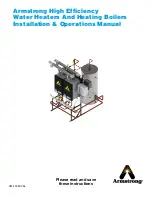
North America • Latin America • India • Europe / Middle East / Africa • China • Pacific Rim
armstrong
international.com
Designs, materials, weights and performance ratings are approximate and subject to change without notice. Visit
armstrong
international.com for up-to-date information.
14
Gas Connection
Gas Connection
Figure 3.1 - ABH GAS CONNECTION
The gas supply shall have a maximum inlet pressure of less than 14” water column (1/2 PSI) (3.44 kPa), and a minimum of 4”
water column. The entire piping system, gas meter and regulator must be sized properly to prevent pressure drop greater than 1”
as stated in the National Fuel Gas Code. This information is listed on the rating plate.
It is very important that you are connected
to the type of gas as noted on the rating plate,
“LP” for liquefied petroleum, propane gas or “Nat” for natural or city gas. All
gas connections must be approved by the local gas supplier, or utility in addition to the governing authority, prior to turning the
gas supply on. It is mandatory that a drip leg be fabricated, as per the National Fuel Gas code. Once all the inspections have been
performed, the piping must be leak tested. It is recommended that a soapy solution be used to detect leaks. Bubbles will appear on
the pipe to indicate a leak is present. If the leak test requirement is a higher test pressure than the maximum inlet pressure, you must
isolate the ABH from the gas line. In order to do this, you must shut the gas off using factory and field-installed gas cocks (following
the Lighting Instructions page 36.) This will prevent high pressure from reaching the valve. Failure to do so may damage the gas
valve. In the event the gas valve is exposed to a pressure greater than 14” water column, the gas valve must be replaced.
Never use an open flame (match, lighter, etc.) to check gas connections.
B. Gas Piping
The gas piping must be sized for the proper flow and length of pipe, to avoid pressure drop. Both the gas meter and the gas regulator
must be properly sized for the total gas load. If you experience a pressure drop greater than 1” WC, the meter, regulator or gas line
is undersized or in need of service. You can attach a manometer to port 3 of the gas valve (see Figures 3.2 and 3.3 on the following
page). Alternatively, you can attach the manometer to the incoming gas drip leg, by removing the cap and installing the manometer.
The gas pressure must remain between 4” and 14” during stand-by (static) mode and while in operating (dynamic) mode.
If an in-
line regulator is used, it must be a minimum of 10 equivalent feet from the ABH. It is very important that the gas line is properly
purged by the gas supplier or utility. Failure to properly purge the lines or improper line sizing, will result in ignition failure.
This problem is especially noticeable in NEW LP installations and also in empty tank situations. This can also occur when a utility
company shuts off service to an area to provide maintenance to their lines. This gas valve must not be replaced with a conventional
gas valve under any circumstances. As an additional safety feature, this gas valve is easily de-coupled from the fan inlet.
Refer to the following tables to size the supply piping to minimize pressure drop between meter or regulator and unit.
1/2"=1'
Dwg. By:
34000 Autry
Livonia, MI 48150
PH: (800) 968-5530
Fax: (734) 419-0209
Description:
Date:
Scale:
Customer:
HAMILTON
ENGINEERING
Dwg.
No.:
Checked.
By:
(2) HWD299's to HET 120
Gas
Supply
Drip
Leg
Gas
Shut-off
Valve
DANGER! Failure to follow all precautions could result in fire, explosion or death!















































